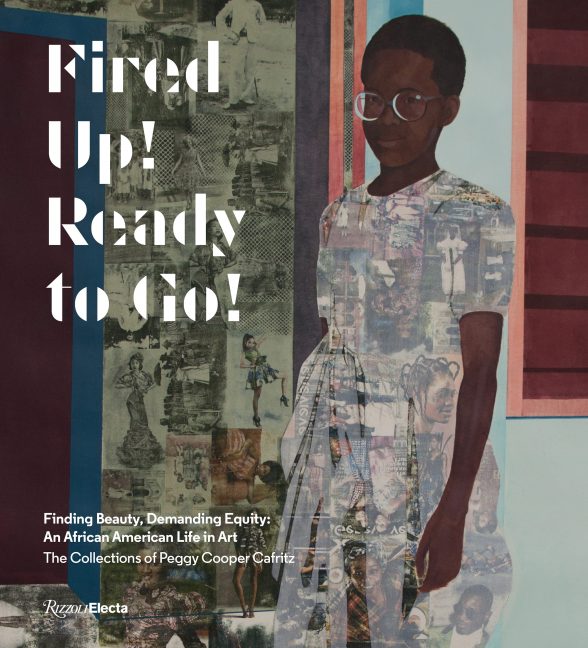Art collector Peggy Cooper Cafritz died only days before her book, “Fired Up! Ready to Go!” debuted in February, 2018. The timing of the book’s debut turns the book’s title — the exhortatory Obama campaign slogan — into an unintentional valedictory for Cafritz, who was indeed Fired Up! (And Went!) many places in her activist and engaged life.
An art archive and a memoir

A large, commanding book of 288 pages (and 200 color illustrations!), Fired Up! is an archive of the sculpture, photographs and paintings collected by Cafritz. But it’s also a memoir — very worth reading — with the art, together with the collector’s in-depth autobiographical essay, telling you as much about the woman herself as about the art. It is very important to read Cafritz’s story (and her peppery photo captions) and consider her words and life, while looking at the pictures of the work.

Born in Mobile, AL, Peggy Cooper grew up in a prosperous family with a father and mother who inculcated in her the importance of equality and beauty.
As a young girl, she was reading James Baldwin in 5th grade and had family dinner with Martin Luther King, when she was in 6th grade. She also learned first hand to negotiate with white racist institutions and people, when her family sent her to all-white summer camps in Michigan and a boarding school in Indiana. As a young woman, she went to George Washington University, undergrad and law school, at a time when the college was segregated.
While in college she and friends began organizing the Duke Ellington School of the Arts in Washington, D.C., to educate and encourage African American youth and empower them to rise in the white art world. Ellington, a D.C.public high school established in 1974, has some illustrious alumni, including Dave Chapelle and Hank Willis Thomas, both notable successes in the arts and culture world. Thomas, who was a museum studies student at the school, says about Cafritz (who was a strong supporter and collector of his art) that the Ellington school might be her greatest contribution.
Collecting art, a fire, and collecting more art
Peggy Cooper married D.C. real estate developer Conrad Cafritz in 1981 (they had already been together for 8 years), and they had a son, Cooper, in 1984, and adopted two other children. Cafritz and her husband divorced after 17 years of marriage. Throughout her adult life, she has fostered dozens more children.
Her art collecting began when she was an undergraduate, collecting African masks. When she collected, it was with an eye towards supporting the artists but also to living with the art, which she did. In 2009, a tragic house fire took everything, including her precious family pictures and kids art, and 300 works of art. Luckily, nobody was injured in the fire. This cautionary lesson about living with your art didn’t stop Cafritz from collecting more and and living with it, albeit in a more modern building, presumably more fire-safe than the sprawling suburban mansion that burned down.
Confident, activist and earnest
Showcased in this book, the collection is an amazing mix of works by younger, and established black artists. Names of note include Kerry James Marshall, Njideka Akunyili Crosby, LaToya Ruby Frasier, Robert Pruitt, Amanda Ross Ho, Jacolby Satterwhite, David Hammons and Lynne Boake-Yiadom, to name a few. You might not yet know the names of the others. Some artists are students or alumni from her Duke Ellington School. And she displays their works proudly in the book alongside the acknowledged greats. It’s a generous move and right, for a collector who was also an educator and totally connected to young people.
Cafritz tells her story in a voice, which, like the spirit of the art she collects, is confident, activist and earnest. The 27-page reminiscence, punctuated by family photos, contains many confessional asides that explain her personality — she was relentless in her search for beauty because she didn’t see it in herself; segregation taught her you can’t have beauty without equality.
Some of the facts in Cafritz’s story, like her father’s suicide in 1969, and the two times she was raped, are bombs dropped into a tale of a girl of privilege. Perhaps these stories could not have been told publicly before the “Me-Too” era, but in a book by and about an empowered woman, that emphasize beauty and equality, these incidents of ugliness and hurt are appropriate and appropriately jarring.
Call out to the white art world “in crowd”
Cafritz is at her most fiery when she is calling out the “in crowd of the white art world,” curators, museum directors, gallerists, collectors. She says white curators are not qualified to curate African American art and culture because they don’t know it. And she calls for the in crowd to get itself educated about what they have been wrongly excluding from their midst. There should be more equality in art education, she says, adding that the art world should open up and be inclusive of curators, educators, artists and collectors of color.
Paging through the book, you see that Caffritz’s collection focuses heavily on the faces and bodies and stories of African American people. You also see that in her highly revealing memoir, Caffritz is inviting you to look at another “face,” hers, which she never felt was beautiful, but which, as conveyed in the passion of her words, radiates an inner beauty as strong as that of the works she collected.
FIRED UP! READY TO GO!
Finding Beauty, Demanding Equity: An African American Life in Art
By Peggy Cooper Cafritz
Rizzoli Electa, 2018
Hardcover with jacket, 9.5” x 10.5”, 288 pages, 200 color illustrations, $75
Amazon $49.73





